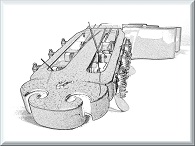Welcome to one of the most active flamenco sites on the Internet. Guests can read most posts but if you want to participate click here to register.
This site is dedicated to the memory of Paco de Lucía, Ron Mitchell, Guy Williams, Linda Elvira, Philip John Lee, Craig Eros, Ben Woods, David Serva and Tom Blackshear who went ahead of us.
We receive 12,200 visitors a month from 200 countries and 1.7 million page impressions a year. To advertise on this site please contact us.
|

|
|
Tonewood and wood-boring beetles
|
You are logged in as Guest
|
|
Users viewing this topic: none
|
|
Login  | |
|

  
Ruphus
Posts: 3782
Joined: Nov. 18 2010

|
 RE: Tonewood and wood-boring beetles (in reply to kominak) RE: Tonewood and wood-boring beetles (in reply to kominak)
|
|
|
Only sent through G-translator, but I think it should be understandable.quote:
The woodworm
In woodworm is to have no real worms. Actually, these are mostly the wood-eating larvae of the ordinary gnawing beetle (lat. Anobium Punctatum).
They eat the cellulose in the early wood and destroy out so expensive furniture and supporting construction wood from the inside.
In the choice of wood, the larvae are undemanding. They attack not only fresh timber, but also centuries-old wood parts.
Did you know already….
The common furniture beetle is also known as "death-watch beetle" because it suggests in the mating season with his head on the wood to attract sexual partners. Previously it was thought that knocking would announce the approaching death.
The mother beetle lays laying eggs between 20 and 50 eggs in small cracks and openings in the timber. Often even in the same piece of wood, in which she is self-grown.
The development of the larvae may, depending on their condition, be between 1 and 8 years. It depends on the temperature, the moisture and the protein content of the wood on.
Between April and August, the larvae pupate and eat up to the surface. The resulting holes called flying holes which may have a diameter of 1 to 3 mm.
How to Spot the infestation
An active woodworm infestation can be recognized by small sawdust pile under the component or furniture. When eating they are transported out of the timber.
By temperature changes and other influences, it may happen that the larva inserts a feeding pause and during this period no ejects wood flour. Thereby, it is sometimes not easy to detect an infestation.
Wolverine noise can be another clue that indicates the wood pests.
The control methods
To combat woodworm some methods have evolved over the centuries. Some of them are very effective, while others delusion. Let's look at each method in more detail at:
Thermal treatment
Woodworm exist, like most insects, to a large extent from protein. And as everyone has noticed with a tasty scrambled eggs ever, the gelatinous protein above a certain temperature is determined. This circumstance you can take advantage of even when the woodworm and heat the wood.
Above a temperature of 55 ° C, the protein starts to coagulate in the larvae, making them die. Here, since the timber must be heated up to the innermost layer, it should be exposed to this temperature for about 1 hour.
The wood moisture should be noted, as tends to dry wood cracks.
There are several ways to heat the piece of furniture when it is portable:
Smaller pieces of wood can be wonderfully heated to the required temperature in the oven or a microwave device.
Larger pieces of furniture can also be heated in a sauna.
If no sauna are prepared and the furniture too large for the oven, you can build its woodworm sauna in the summer itself. For this purpose, one discovers the wood from a black tarpaulin, most airtight. By sunlight, the temperature rises under the tarp to dramatically and achieved so loose the required 55 ° C. To check a thermometer can be used.
In summer, the interior of cars often developed a high temperature. This one can take advantage of and store the piece of furniture for several hours in it.
Since the animals are adapted to the low temperatures in winter, the freezing of the piece of wood works very poorly. In addition, wood has excellent insulating properties and therefore must be cooled for several hours.
Chemical treatment
In chemical woodworm toxins, such as those found in tree market, a distinction is made between slow-acting poisons ingested and hormone and quick-acting nerve poisons. Since these toxins can be dangerous for people they should only be applied in extreme cases.
Mostly they are injected individually with a thin rod or a syringe into each well. It is imperative gloves and goggles must be worn.
A further possibility is the gassing of the timber parts. However, this procedure should only be performed by a professional, because the chemicals used are toxic for man and environment.
Home remedies
Since the larvae do not like dry wood below 10% wood moisture, often leads the dry heated air in the cold seasons larval death. Therefore, one can an affected piece of furniture for a few months at rest in a heated room and keep the humidity low.
Afflicted wooden posts
An old home remedy for woodworm is the laying out of acorns. The larvae leave the timber and infest the acorns. Once a hole in the shell, it must be replaced. After several weeks, you should be rid of all woodworm.
Other home remedies, such as ammonia, kerosene, turpentine, cedar oil, boric salt, vinegar or lemon have only partly and can also attack the wood surface.
After the woodworm was successfully sold, the resulting holes can be sealed with colored wax or wood putty.
Ruphus
|
|
|
|
REPORT THIS POST AS INAPPROPRIATE |
Date Sep. 11 2015 13:06:26
 |
|
 New Messages New Messages |
 No New Messages No New Messages |
 Hot Topic w/ New Messages Hot Topic w/ New Messages |
 Hot Topic w/o New Messages Hot Topic w/o New Messages |
 Locked w/ New Messages Locked w/ New Messages |
 Locked w/o New Messages Locked w/o New Messages |
|
 Post New Thread
Post New Thread
 Reply to Message
Reply to Message
 Post New Poll
Post New Poll
 Submit Vote
Submit Vote
 Delete My Own Post
Delete My Own Post
 Delete My Own Thread
Delete My Own Thread
 Rate Posts
Rate Posts
|
|
|
Forum Software powered by ASP Playground Advanced Edition 2.0.5
Copyright © 2000 - 2003 ASPPlayground.NET |
0.0625 secs.
|


 Printable Version
Printable Version









 New Messages
New Messages No New Messages
No New Messages Hot Topic w/ New Messages
Hot Topic w/ New Messages Hot Topic w/o New Messages
Hot Topic w/o New Messages Locked w/ New Messages
Locked w/ New Messages Locked w/o New Messages
Locked w/o New Messages Post New Thread
Post New Thread